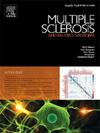Assessment of the enhanced paper grip test for quantifying balance deficits in people with multiple sclerosis: A reliability and applicability study
IF 2.9
3区 医学
Q2 CLINICAL NEUROLOGY
引用次数: 0
Abstract
This study assessed the reliability and applicability of the Enhanced Paper Grip Test (EPGT) for quantifying balance deficits in people with multiple sclerosis (MS). Thirty individuals with MS (mean age: 41.9 ± 9.66 years, mean Expanded Disability Status Scale (EDSS) score: 2.13 ± 0.94; mean disease duration: 8.3 ± 6.0 years) were recruited. The EPGT demonstrated excellent intra-visit reliability, with intraclass correlation coefficients (ICC) of 0.96 (95 % CI: 0.93–0.98) for the weaker side and 0.94 (95 % CI: 0.89–0.97) for the stronger side. Inter-visit reliability, assessed in 15 participants, also showed excellent ICCs (0.97–0.99), with coefficients of variation ranging from 4.23 % to 5.50 %. Additionally, high and statistically significant correlations were observed between EPGT performance and balance, as assessed by the modified Mini-BESTest (r = 0.81–0.87, p < 0.001). Small but statistically significant correlations were found between EPGT results and EDSS scores (r = −0.36 to −0.38, p < 0.05). These findings suggest that the EPGT can reliably assess foot/ankle strength and identify balance deficits in people with MS, with potential clinical application for monitoring disease progression and guiding rehabilitation interventions. The EPGT may provide a simple and effective method for identifying balance impairments in MS, potentially supporting early interventions and fall prevention strategies
求助全文
约1分钟内获得全文
求助全文
来源期刊

Multiple sclerosis and related disorders
CLINICAL NEUROLOGY-
CiteScore
5.80
自引率
20.00%
发文量
814
审稿时长
66 days
期刊介绍:
Multiple Sclerosis is an area of ever expanding research and escalating publications. Multiple Sclerosis and Related Disorders is a wide ranging international journal supported by key researchers from all neuroscience domains that focus on MS and associated disease of the central nervous system. The primary aim of this new journal is the rapid publication of high quality original research in the field. Important secondary aims will be timely updates and editorials on important scientific and clinical care advances, controversies in the field, and invited opinion articles from current thought leaders on topical issues. One section of the journal will focus on teaching, written to enhance the practice of community and academic neurologists involved in the care of MS patients. Summaries of key articles written for a lay audience will be provided as an on-line resource.
A team of four chief editors is supported by leading section editors who will commission and appraise original and review articles concerning: clinical neurology, neuroimaging, neuropathology, neuroepidemiology, therapeutics, genetics / transcriptomics, experimental models, neuroimmunology, biomarkers, neuropsychology, neurorehabilitation, measurement scales, teaching, neuroethics and lay communication.
 求助内容:
求助内容: 应助结果提醒方式:
应助结果提醒方式:


